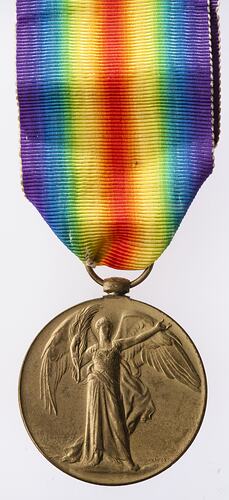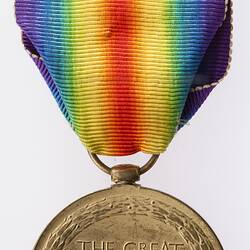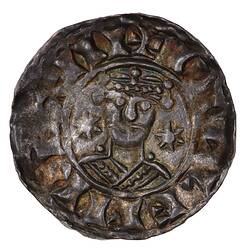Summary
Victory Medal 1914-1919 with ring mount and ribbon awarded to Pte. Alfred Sanderson Skilbeck, service number 2190, 26th Battalion, A.I.F.
Private Skilbeck was born in Bendigo, Victoria. He was a miner before he joined on 19 September 1915 at Claremont, Tasmania, aged 22 years. Skilbeck embarked from Brisbane (Skilback on roll) on 20 September 1915 on HMAT Armadale. In 1916 he was in Egypt and he took leave in May 1917 to France. Skilbeck suffered from gonorrhea shortly after and was treated several times. He rejoined his battalion in September 1917. Private Skilbeck was discharged in 1919 as medically unfit. In 1923 he was residing at 162 Pearson St, West Brunswick.
The Victory Medal was authorised in 1919 and was awarded to army, navy and air force personnel who served in a theatre of war between midnight 4th-5th August 1914 and midnight 11th-12th November 1918. The Allies resolved that, if they wished to issue a Victory Medal, it would share a common feature of a depiction of Victory on the obverse and a ribbon of red, yellow, green, blue and violet merged into a rainbow pattern. This medal, that of Great Britain, was awarded to personnel from countries in the British Empire (some 5,725,000 were issued). The other Allied countries that issued Victory medals were: Belgium, Brazil, Cuba, Czechoslovakia, France, Greece, Italy, Japan, Portugal, Romania, Thailand, Union of South Africa and the United States of America.
Obverse Description
Figure of Victory facing three-quarters right with wings spread; in her right hand she holds a palm branch, her left hand is extended and open. The artist's initials, W.McM. (W. McMillan) are above the ground line on the right.
Reverse Description
The words, 'THE GREAT . WAR FOR . CIVILISATION 1914-1919' within a circular wreath of laurel.
Edge Description
Text; '2190 PTE. A.S. SKILBECK. 26 BN. A.I.F.'.
More Information
-
Collection Names
Military Memorabilia Collection, Returned and Services League (RSL) Collection
-
Collecting Areas
-
Acquisition Information
Donation from Victorian Branch, Returned & Services League of Australia Limited (RSL), Mr A. Richards, 01 Aug 1983
-
Date Issued
1919 AD
-
Issued By
-
Mint
-
Artist
-
Awarded To
Private Alfred S. Skilbeck, Australia, 1919
2190 Pte A.S. Skilbeck. 26th Battalion, A.I.F. -
Inscriptions
Obverse; 'W.McM.' (W. McMillan- artist). Reverse; 'THE GREAT . WAR FOR . CIVILISATION 1914 - 1919'. Edge; '2190 PTE. A.S. SKILBECK. 26 BN. A.I.F.'.
-
Material
Bronze
-
Axis
12
-
Classification
-
Category
-
Discipline
-
Type of item
-
Overall Dimensions
50 mm (Height), 36 mm (Outside Diameter)
Height to top of ring.
-
Shape
Round with loop and ribbon
-
References
References: [Link 1]
[Book] Joslin, E C., et al. 1988. British Battles and Medals., 230 - 1 Pages
-
Keywords






